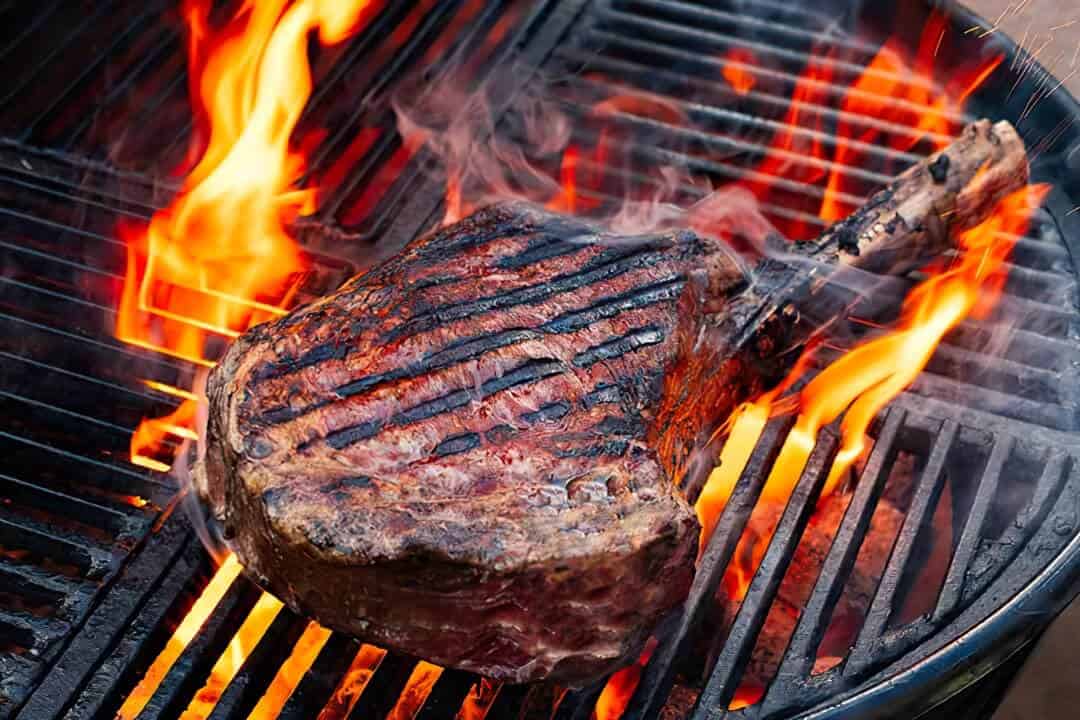You may not realize it, but you probably have already used direct heat grilling on your barbecue. Although most don’t know the name for it, it is the standard, “bread and butter” cooking style on your outdoor barbecue. I will explain what it is, how to do it, and what it is good for right here!
So what is direct heat anyway?
Direct heat is produced when you cook your food directly over the hot coals or burner so that radiant and conductive heat directly heats and cooks your food. This is as opposed to indirect heat in which your food is removed somewhat from the heat source. The difference is that indirect heat cooking, higher temperatures are produced on the surface of your food, cooking it faster, allowing you to sear the surface quickly, while with indirect heat your food cooks slower with convective heat surrounding and slow roasting your food.
To better understand the difference, compare searing a piece of meat in a hot skillet on your stovetop versus roasting a chicken in your convection oven. The skillet produces high direct heat that is in contact with your food, quick cooking and even browning the surface of your food. In the oven, the heat source is somewhat removed and supplies hot air that surrounds and envelopes your roasting chicken, slowly cooking throughout to juicy doneness.
Therefore, while indirect heat is best for larger roasts or cuts that you want to roast slowly and cook thoroughly throughout, direct heat is best for:
- Smaller cuts of meat that don’t take long to cook (examples: sausages, hot dogs, burgers, smaller chicken pieces)
- Foods you just want to sear and leave the inside less cooked or raw (examples: rare or medium-rare steak, seared Ahi tuna)

How do you Direct Heat Grilling?
Direct heat cooking is easy! Actually, it’s not really any different than you are probably already doing. While indirect heat requires a special setup, direct heat cooking can be done fast on any grill or barbecue.
- If using a charcoal grill, simply start your coals as you usually would. When they are ready, spread them out in a uniform layer on your charcoal grate so that they are all pretty much the same distance from your cooking grate.
- If you are using a gas or natural gas barbecue, simply ignite your burners and turn them up relatively hot.
- You want the coals or burner to be close to the cooking grate and directly under your cooking area so that it produces intense heat. To test this, hold your hand about 4 inches from the surface of the grate. If it is hot enough, it should be very uncomfortable to hold your hand there longer than 3 seconds or so.
- Now simply add your food as you usually would. However, don’t just walk away! Direct heat cooks food fast at its surface, so if you leave food too long it can easily burn. Also, if food is fatty, dripping fat can catch fire on your burner or coals and produce large flames which will quickly char your food into charcoal! So stay by your grill and tend to your food. When one side is done, flip the cooking food. If flare ups do occur, either move the food or put the flare up out with a spray bottle of water.
- Slightly larger pieces of meat that take longer to cook (such as chicken breasts, larger burger patties, large sausages) may need to be moved numerous times on the cooking surface to avoid burning before the inside is done.
- If you are flavoring your food with a sauce, like BBQ sauce or teriyaki for example, with direct heat you should add the sauce towards the end of cooking by basting it with a basting brush. If you add the sauce early, the high direct heat will quickly caramelize the sugars in the sauce and eventually burn it into a crispy black crust. While you want a little bit of caramelization and browning to occur, you don’t want a layer of burnt sugar or charcoal on your food! So baste your food with your sauce when there are only a few minutes of cooking time left.
That’s pretty much it! No rocket science or brain surgery here, just good ol’ grilling!
If you want more info on how to cook the perfect steak, see my Classic Grilled Beef Steak Recipe.
If you are ready to learn a bit more advanced form of cooking, go learn about indirect heat cooking. It is perfect for larger roasts or foods that you want to slow cook so that it is thoroughly done throughout, juicy and tender.
Hi, I’m Adam and I’m a HUGE fan of Food and Cooking.
Do you enjoy grilling sessions with your family while staring at the beautiful fire pit flames?
Flame Gorilla is the site to learn how to have that perfect backyard experience.

